Bikernet West – Amazing Progress
By Robin Technologies |
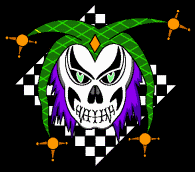

Late into the evening, Bandit, Nuut Boy, and my wonderfully-knowledgeable- self hammer, weld, bolt, space, and tear our beards out moving forward on Bandit’s rigid. The Weerd Bros front end is in place with the Roadwings 21-inch, 40-spoke wheel. The rear is a 180-18, both with Avon tires. The frame is stretched 6 inches up and 2 out. The trees on the clean front end are raked 6 degrees (photo 1). The S&S 98-inch stroker is bolted in place as is the 5-speed Sputhe trans.
We set the engine and tranny in place and then found a scrap inner primary to line everything up. With the stock 32-tooth pulley on the tranny, we put a 70-tooth narrow belt pulley from Harley on the back with a 134-tooth belt. It was too long. We tried to get a hold of the frame manufacturer for some guidance, but they wouldn’t get back to us, so we had to wing it. We had another option. Run a Harley Thunderstar 65-tooth wide pulley for taller gearing for the trip. We picked up a 130-tooth belt and it fit like a glove. The pulley on the wheel also felt good and afforded us plenty of tire clearance with the offset frame. With the rear wheel in the center of the adjustment axle slot and the tire centered in the frame, it was time to fit the rear fender. The rear fender was a Milwaukee Iron job, which took some time to mount up. First we centered the tire in the frame. Ignore the offset rear leg. Center it in the frame using the cross member behind the seat as a guide. We centered it then strapped chunks of 3/4-inch board (photo2) to the tire with green paint masking (low tack) tape.
Then we slipped the fender in place after the rear belt was adjusted. Again, make sure the fender is centered over the tire. The fender didn’t contour the tire completely, so you must decide what area you want contoured. We decided on the top, most visible area. Make sure the slot for the belt rides a good two inches above the belt and at least a 1/4-inch from the inside.
Then the Samson exhaust was removed from the box. They don’t build exhaust for rigids so natch the Dyna exhaust didn’t fit, since with rubbermount frames the engine sets higher in the chassis. They were also over 10 inches different in length. For performance we cut them to a more equal length (photo 4), about 27 inches.
We also ordered baffles and we cut them (guessing) to give the 2 1/4-inch exhaust some back pressure. Then we mounted them. The front pipe was way too close to the deck, so we cut 2 inches out of it and gas welded the pipe back together. During this process we were able to bring the pipe into closer alignment with the rear exhaust. None of the brackets would work so the madman with a torch went to work building brackets. The seat was also a trick. Bandit purchased an old cop solo with the plunger t-bar from 34th Station, a bike restoration shop on Pacific. After much contemplation he decided that he had to mount springs under the seat for something of a ride, but springs were a problem. He had some success with a set of valve springs on his dicey Knucklehead, “Made all the difference in the world,” Bandit said while pondering the ride. But the old Bates tapered 2- or 3-inch springs generally bottom out under any load. Then a bolt of lightening hit while attending the Harley-Davidson new model presentation to the motorcycling press. In addition to all the new models for 2001, they were showing off their new police bike, which had a sprung seat. Bandit drew the 4-inch crescent wrench he’s been carrying in his pocket for the last 32 years and began to take the springs off the new 2001 model. Seven factory executives struggled to pull him off the new demo bike. “But wait, guys. I just want to borrow ’em,” he screamed, pulling on his crescent wrench. Back at the top-secret massive 50-square-foot Bikernet testing facility, the gang was taking more measurements. It was determined that if he could narrow the seat one inch, all would fit, and the seat spring studs would line up with the center of the frame tubes. A call was made to California Harley-Davidson to order the springs, ASAP. Nuut Boy went to work stripping the seat to just the pan. With a die-grinder he cut a 1-inch strip out of the center of the pan then laid enough brazing rod into the jagged gap to sink a battleship. We decided not to use the old t-bar and with some standard 3/8-inch round stock, fashioned a triangle brace under the seat for support.
|
Bikernet East Installment 5
By Robin Technologies |
629 E. Sunrise Blvd
Ft. Lauderdale, Fl 33304
| “I’m thinking of having a painter do up the bottom of the bike with some radical paint design because the fucker is so damned fast with this S&S 113 that it brings the front end off the ground in second gear. I’m not kidding. I had to switch it back to a chain from a belt, because the belt would just sit there and whizzzz, spin like crap and fry.”
“The customer is completely nuts,” Eddie Trotta continues, as he closely examines a gorgeous, low-slung chopper which he hand built for a local Fort Lauderdale, Florida client. “The fuckin’ guy, he walks in here, I let him take a ride, he comes flying back in and says, ‘Jesus Christ! That’s the best running motorcycle I’ve ever ridden! How much?!’” “I tell him ‘$40,000, he writes a check and then, then the crazy motherfucker spends the next half an hour, eeeeeeeeeeeeowww! ZZZZZoooooommmm! Back and forth, roaring up and down the street out front like he wants to kill himself on this fast damned scoot. We’re all in here watching with our jaws on the floor and this guy’s outside going completely nuts. Finally, he comes back in grinning like a lunatic, the thing’s smoking like crazy, the back tire’s fried and he laughs and says, ‘I gotta let you guys know, I ride pretty hard. This thing has to be bullet proof.’ I asked, ‘Can I give you your money back right now?’ And he says, ‘Hell no! I love this thing! It’s tough as shit!’” Eddie lets out a casual laugh as he pulls a massive hunk of turf out from under the bike. “What’s this?” he asks incredulously looking at what appears to be golf course sod wedged under the bike. “What the hell? I think he’s taking this thing off road! That crazy bastard. He came in here the other day with a tiny crack in the back fender. Turns out he JUMPED the sonofabitch with his old lady, some broad who’s huge and he actually cracked this fender. Feel how thick this thing is! That’s the heaviest fender made in the business. I gotta get this guy a slower bike or a lighter old lady. Or a shorter ramp. He’s totally nuts.” I feel the metal and it is a really heavy fender, a beauty. “He jumped it?” I ask, thinking I must have heard wrong. “Yes! I’ve fixed this tiny running light down here behind the pipes at least 15 times. That’s a $100 light. I’m going broke off this one light!” Eddie says laughing, examining the light closely. “I don’t know how the hell he’s doing it, probably has flames shooting out of the pipes and he’s melting it or something, shit I don’t know. The guy owns 53 businesses, he’s my roughest riding customer. Totally nuts. I fix it all for him for free. I stand behind my choppers. Once in a while he puts up a new gutter at my house. It evens out.”
Good customer service? You be the judge, but by my standards, that’s going above and beyond. Stands to reason. If you want a gorgeous custom chopper and I mean gorgeous by the most rigorous show standards, a no-nonsense, built to ride, powered by beat-the-motherloving-crap-out-of-it equipment like RevTech engines and Baker trannies, Eddie Trotta at Thunder Cycle Designs is the man. Eddie’s is one of the nation’s premier custom motorcycle builders, specializing in one-of-a-kind choppers. He started building in the 70’s and opened his shop, Thunder Cycle Designs in Fort Lauderdale, Florida in 1990. Currently he has around 50 custom bikes for sale on his showroom floor at any one time and there is nothing that he can’t build for a serious customer.
“My bikes average about $40,000,” Eddie tells me as he cranks up a gorgeous new chopper with a stunning paint job. The big S&S 113 rumbles to life. “Sit on it, tell me what you think of this shape.” I gladly get on and the long, elegant monster fits like a high-speed glove. This is what it must feel like for a fighter pilot to slip into the seat of a well-oiled F-16, I think. “I try not to price my motorcycles into dumbass numbers,” Eddie says.
“Which some other builders do. My goal is to make an incredible, unique chopper for my customer and sell it to them at a reasonable profit and have them ride the crap out of it. These bikes aren’t built for trailers. I build them to ride. Sure, they look pretty, but they run like motherfuckers. I have some customers who trailer from show to show and that’s okay, but I still build them with the components to ride and ride hard. These are motorcycles, not art. They might look like art, but first and foremost, they’re hardcore machines.” “And now we come to Zebra chopper,” Eddie says, winking. We walk up to my new chop, the Great Northern Steamer, my entry into the fierce Bikernet.com Chop-Off competition for Sturgis 2000. This will be the horse, which I try to beat the mighty Bandit with, out on the West Coast. Taking on the Godfather of motorcycling isn’t an easy task which is why I’ve called in the master, Eddie. “I’ve taken the fender off and re-cut it. It was okay the way you had it, but we made it better, hugs the tire tighter. Eddie Meeks, at Hardly Civilized is painting in the artwork (5437-A Church St., Greensboro, NC 27445, 336.545.9064) now,” Trotta says. Eddie Meeks, one of the top painters around, was kind enough to light up his spray gun and blast off a paint job in just under a week, including curing and shipping time. “I put on a different kickstand, rear passenger pegs, we’re going to raise the bike a bit as well. I might change out these brakes on front, put on two small calipers instead of the one big one. Not sure yet. We’ve taken off the back tire, checked all the alignments, double-checked all the rear end, it looks good. This is the seat. It’s a custom job, made from a nice tan leather that fits perfectly and matches your paint.” Eddie shows me my new seat, a hand built beauty, which ends in a fine dovetail over the bobbed fender where the lass will perch. “You’ve got a great tranny with this Baker six-speed,” Eddie continues, “which is what I use on my bikes. These RevTech 88’s are beauties, too. They’re strong and smooth. I’ve had no problems with either the Bakers or the RevTechs, and you know how my customers ride,” Eddie says, rolling his eyes. “You don’t plan to jump the motorcycle, do you?” “Not voluntarily,” I tell him. “But of course, it is Bikernet, so it would be foolish to rule out such things entirely.” Eddie chuckles and shrugs. “That’s true,” he says, “I’ve known Bandit for a long time and I know better than to put anything past that damned outlaw.” Look for more tech tips coming down from Eddie Trotta and his boys at Thunder Cycle Designs as they finalize the Zebra Great Northern Steamer and the break-in process begins. Eddie Trotta’s Thunder Cycle Designs is located in Fort Lauderdale, Florida. Their web address where you can see Eddie’s entire line of incredible choppers and his full catalog of custom parts (if you don’t see it, call, he can make it), is http://www.thundercycle.com. You can call Thunder Cycle at 954-763-2100. Or, visit Eddie and his metal magicians by taking I-95 to Fort Lauderdale, to Sunrise Blvd, exit, head east over the tracks to 629 E. Sunrise Blvd, which is on the north side of the street, you can’t miss it and you don’t want to. It’s well worth the trip.
Thanks to Eddie Trotta and his boys at Thunder Cycle Designs, RevTech, Burt Baker at Baker Transmissions, Ken Gold at Gold Rush, and Eddie Meeks at Hardly Civilized. Couldn’t do it without you. Bikernet recommends all these businessmen for your biker needs. They’re tried and true. Gear up, grease up and gas up, all you bros out there. The big run is fast approaching. We’ll see you in Sturgis. Ride hard, |
The Road King Report Installment 1
By Robin Technologies |
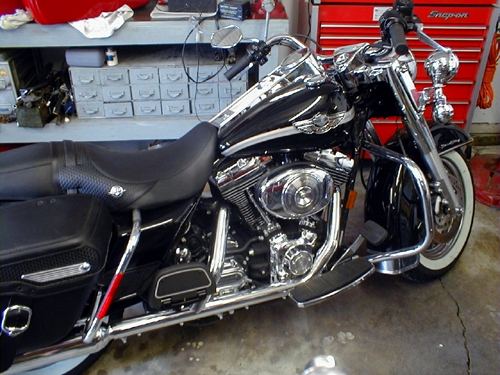
ROAD KING REPORT–Initially I had some questions regarding Road Kings. I wanted to know some about the frame geometry. I perfer a little trail over low speed, parking lot handling. I like to run fast and stable. Next I’m old school. I perfer a bike with minimun extras so I lean toward a carb model over the fuel injection, EFI models.
I immediatly spoke to an expert, Paul from Charlotte, H-D:First as you always say “What year is the damn thing”??????? If it’s a newer model why get rid of the EFI?? The new stuff works good. Harley has new sofware to tune the thing, just out from the dealer show. This will put a big hurt in the Powercomander II and any other after market add on stuff!!!! It’s in the new P&A book for ’03 in the Screamin Chicken (Eagle) section. I like the new Dephi stuff. Also BC Gerolamy has a new dual throat induction throttle body for the Delphi system that is kick ass!!
To take off the system, man it’s lot’s off work. The ECM has all this start up shit it goes thru. checking all the system’s and sensors. Again I have never done this. So to be honest I just don’t know for sure on this one. I can run it by Old Bob tomorrow and see what his thoughts are on both the frame/trees and removing the EFI.
On the frame, my first thought is no. Are you familiar with what they did to the trees? They are not like the old FL stuff at all. The stem is in front of the fork tubes. This makes it a self centering front end. One of the tests they have to do at Talledega on the track is to smack the handle bars hard at 80 MPH++ and see if the damn thing will straighten itself out!!!!
I’ve never thought about doing this so who knows maybe it could be done. Christ you come up some stuff man. Was Jack Daniels involved in all this brain storming??
A week later…
’03 is good year for the Road Queen. The EFI is much better than years past.My question to you is why do you want to loose the EFI?? What are your plans?? Pipes, Big Bore, Stroker kit?? We just did a 103 Stroker kit with cams, heads and a V&H 2-into-one pipe, megaphone, on a ’03 Road Queen for a salesman. He should have used a Thunder Header but most of these clowns want the magazine yuppy chrome look. Shine and billet are in I guess, drives me nut’s!!!!!
You can remove the fuel pump and that shit from the tank. You can put a regular fuel valve in the tank in place of the EFI fuel line. There are two bung’s on the left side of the tank, one is plugged. I did make an adapter for a fuel valve for a Softail EFI bike once. The guy bought these tanks at a swap meet and didn’t know they were for fuel injection.
I think maybe you might just need to change the ECM from EFI to a Carb. ECM. Disconnect the senor’s, eng. temp, crank pos., induction module stuff. Do the tank, install a carb and you might be just be down the road. That way you could leave all the stock wiring and shit in place if you ever wanted to go back to EFI.
On the trees I guess when they went to that style the early top tree was just turned around for that newer style configuration. Don’t know about the setup now. If you did a rotation of the top tree putting the fork tubes forward the bars would be in a different forward location. That would screw up all that headlight cover shit. You might be able to put a complete early FL front end on. Hey maybe even the adjustable sidecar trees. Remember them? The front fork’s are non-air assist now.
I’ll keep plugging away on this “Amazing Raked Road Queen” project for you. I can check out some front end’s and take a better look. Also will try to call tech services at H-D and see what won’t say!!!
–Later, PSD
1928 Shovelhead Comes To California Part VIII
By Robin Technologies |
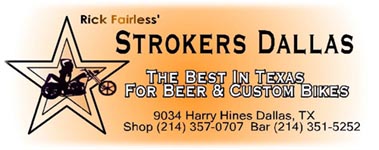
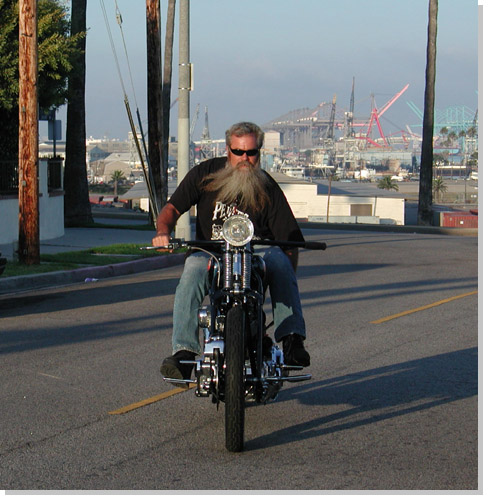
Master builder and mechanic, Deacon, from Pro-Street in Oahu.
Bob Kay. from American Iron Horse. was a bro and shipped the retro Shovelhead. from Strokers in Dallas. to LifeStyle Cycles in Orange County, California along with a new batch of Dallas Choppers. It arrived the day before a handful of weary travelers stumbled into Los Angeles. on their way home, from Sturgis, Glen and Kerry Priddle were headed back to Australia after spending almost a month, with a dozen Aussies, roaming the mid west.

Deacon’s son Chase and the 1928 Shovelhead.
Deacon, his son Chase, and the son’s girl Amanda rode several thousand miles averaging 95 mph wherever they rode. Deacon and Chase are both master mechanics. The ol’ man’s shop, Pro-Street, is located on Oahu, (808) 236-0405 and he’s negotiating with Billy Lane of Choppers Inc. to build engines for Billy’s Discovery Channel Bikes. His son is working in Oregon, but as soon as he returns, he’s packin’ his shit and heading back to the islands.
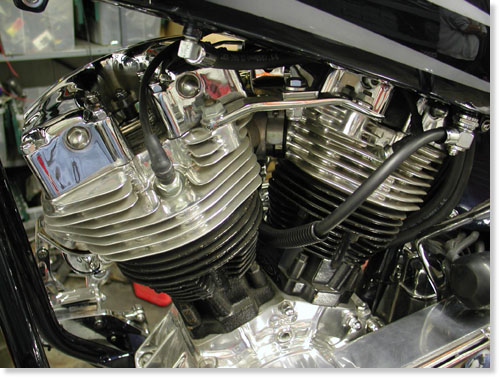
JIMS machine rebuilt and detailed the engine. It was sharp and runs like a top.
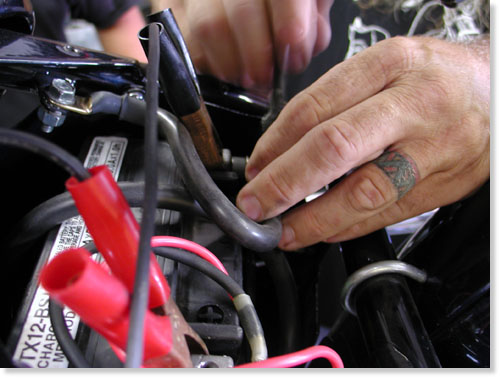
Charging and checking battery connections.
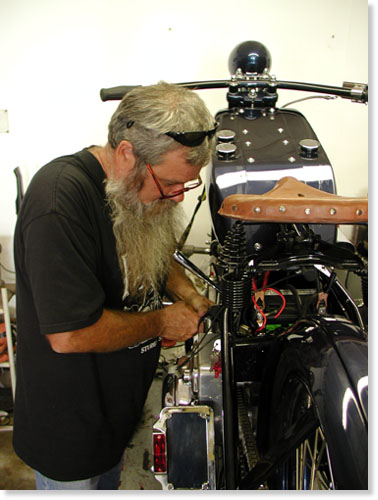
Deacon checking the solenoid.
Deacon rolled into the Bikernet Headquarters just as the Shovel arrived and we attempted to fire the beast to life. I moved the seat forward, detailed the front end and charged the battery. But, even with a fresh battery, she wouldn’t engage. Deacon suspected the aftermarket solenoid. Seems the spacers and gaskets are too thick, just enough to prevent the solenoid from grabbing the shaft. I trimmed the gasket with an Exacto blade and Deacon ground the face of the spacer. Installed, it worked like a champ. We took it for a ride.
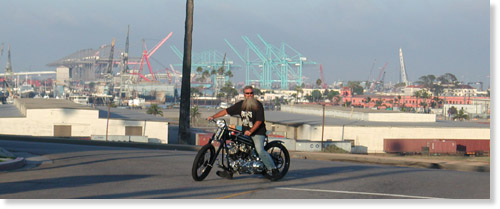
Los Angeles Harbor and our first roadtest.
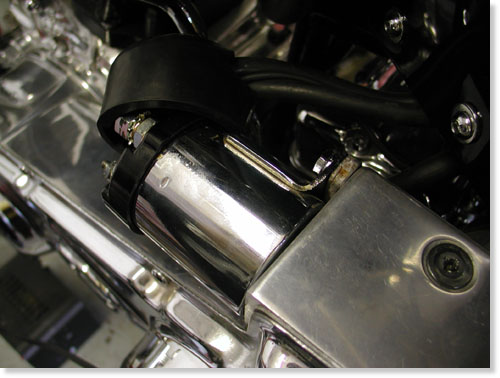
First Deacon checked the connections and voltage at the solenoid. He also shorted across the leads with an Allen wrench to see if the circuit was operating properly.
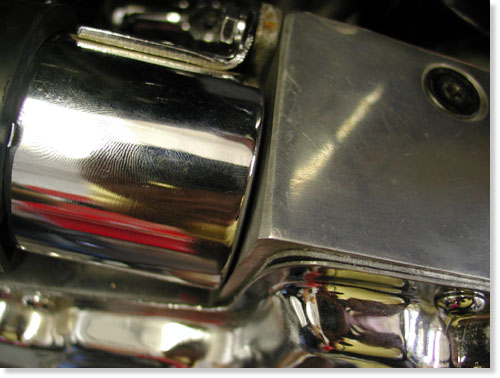
The solenoid replaced after the gasket around the base was trimmed and the spacer, behind the unit, shaved. Worked perfectly.
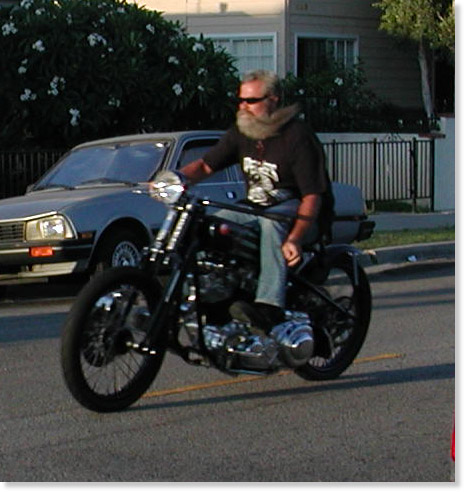
Checkin’ the gears.
It was impossible to jam the suicide shifter into nuetral once the bike was running, even while rolling. Deacon and chase adjusted the clutch, and recommended a Rivera, old school, clutch pack to eliminate chatter and afford the rider smoother shifts. The clutch wobbled and was too tight to find neutral. They loosened the springs until only a thread showed past the adjustment nuts and the spring retainer ran true.
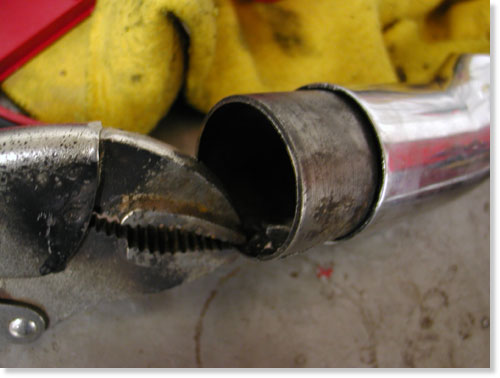
Can you see the cracks?
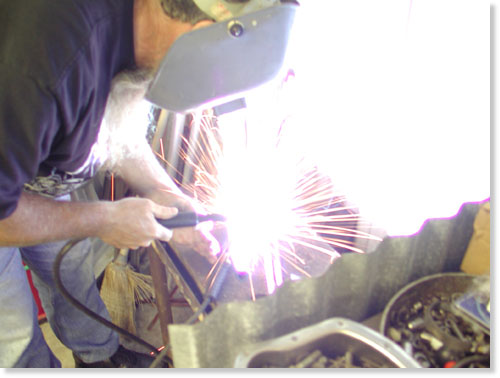
The Millermatic 175 hard at work.
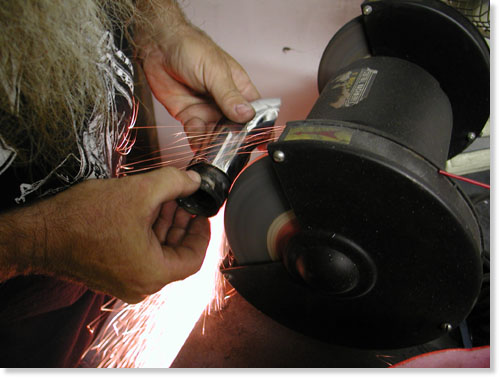
Deacon built a bead then ground it smooth as a baby’s ass.
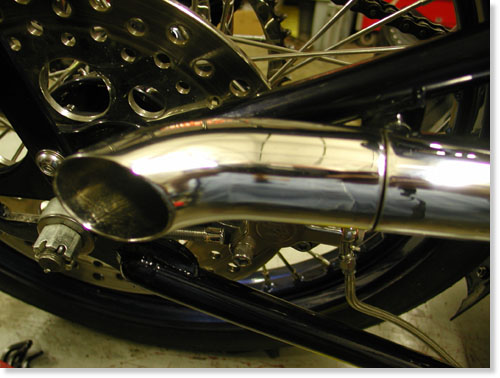
The tip installed, solid as a rock.
I developed padded fork stops and while running we noticed that the clean, handmade, Stroker’s pipe tip was rattling with only one bolt holding it. Upon removal we discovered that the area around the installation nut had already cracked and Deacon grabbed the Millermatic. He welded the cracks and nut for more strength. Then we discovered that the tip shelf was too small, so the pipe end had a tendency to vibrate. Deacon went back to the welder and built a bead around the outside, of the shelf, then ground it to fit. A much cleaner/tighter fit, and the pipe didn’t require an additional fastener.
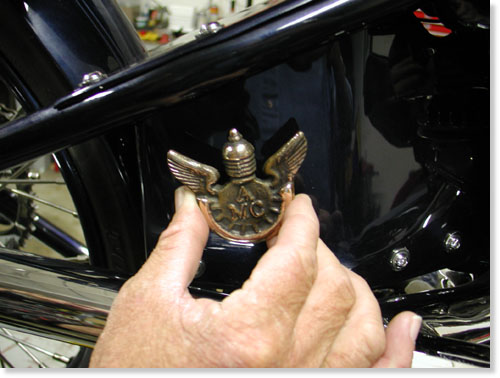
Anybody know how old this cast bronze emblem is?
While in Hawaii at the first Choppers Only Show in Wakiki, I gave Deacon, the promoter, a handmade belt buckle for being a gracious host. He returned the favor with an old license plate doodad from the Antique Motorcycle Club. It was destined for the Shovelhead.
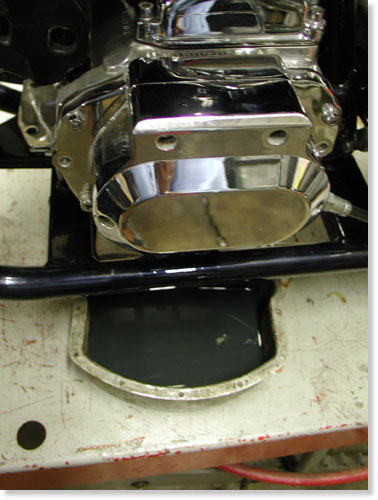
While testing the shifting, clutch and tranny, the gears seemed to bang harshly. We checked the oil level, which seemed precariously low. It wasn’t bad, but we drained the oil and replaced it with fresh Custom Chrome tranny lube.
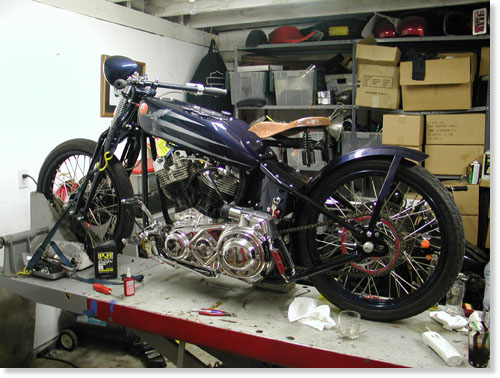
The 1928 Shovel was ready to rock and so were we. Deacon and Glen broke out harmonicas and kicked off the blues. They sampled the Irish whiskey, Tullamore Dew, Sin Wu barbecued and the party rolled on.
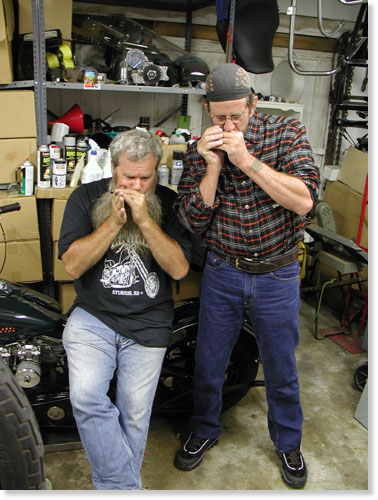
Deacon and Glen bringing down the Bikernet Garage.
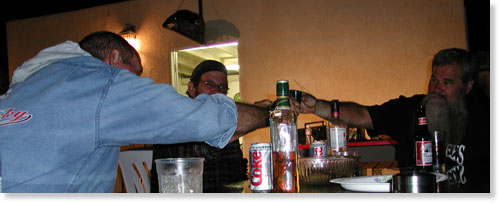
One mo’ shot of Tullamore Dew.
Helluva night, sharp bike and times to always remember. The next day Deacon air-freighted his 2003 FLH to Oahu and grabbed a flight. His son and Amanda boarded their basket case Softail and rode north. Glen and Kerry hid out in Los Angeles and waited for their flight back to Australia, and we dusted off the headquarters and pretended to go back to work.
Stay tuned for the next adventure of the 1928 Shovelhead.
–Bandit
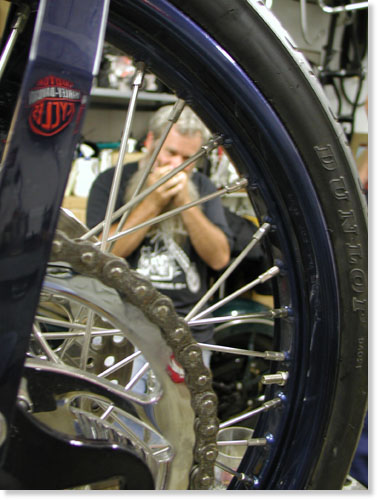

Bikernet West Bogged Down In Pheonix
By Robin Technologies |
|
I knew it! The sonuvabitch couldn’t make it to the Badlands and back on that piece of shit. I knew it! The way Bandit mounted that tank was fucked from the beginning.
 I told him. Nuutboy told him. Harold Pontarelli told him. Shit, his 78-year-old mother told him. Did the big bastard listen? Nooo. So it jumped off the frame in Aspen, Colo., and landed in his lap.
 Yeah, they welded it up in Aspen with the help of Randy Aron from Cycle Visions in San Diego, and he limped into Sturgis, rode around the Badlands for the week and then the scoot was kidnapped from him by someone who knows what the fuck he’s doing, namely Paul Yaffe from Paul Yaffe Originals in Phoenix. Paul is working with Kyle of Independent Tanks, who hand makes steel tanks from heavy 16-gauge material. It’s about time someone grabbed that bike before it exploded into flames and scorched the ornery sonuvabitch.
 So we sent that fly-bitten claybrain to Phoenix for a welding lesson and instructions on how to properly mount a gas tank. If he wasn’t such a hasty-witted old fool, he would have put the bike together right the first time.
 Here are shots of the existing piece of shit with the new tanks recommended by Paul, who builds some of the most innovative bikes on the planet.

 Paul’s philosophy is to manufacture enough custom components to allow his customers to build something without doing a piece-meal job. “Instead of buying fenders from me that don’t fit the other guys’ frame properly and then mount a gas tank from so and so, and nothing fits properly, I want to give the customer half a chance to build a world-class custom on his own.” Paul’s positioning himself, unlike Bandit, to afford customers with frames, plus the fenders, tanks and billet components to match. Paul began his operation building LED taillight products. Unlike the slob who runs this joint, Paul is a young man of vast energy and talent who could not contain himself building bikes with existing components. He began building his own fenders, air cleaners, frames, etc. The young upstart with the flaming red hair does share one notion with Bandit: “If you’re going to build a new full-custom for a customer, I want the bike to be a reliable runner, of the newest technology, or how can you call it a new bike?” So all of Paul’s bikes are built with Harley-Davidson Twin Cam drive lines. “I use as much Harley stuff as possible,” Paul said. “Plus the factory is going crazy building more new accessories all the time. The selection is growing by leaps and bounds.” Damn, if I told that lunkhead Bandit once, I told him a thousand times, it’s time to move away from the Evolution shit into the real world of Twin Cams. But that motley-minded minnow is still out in the garage trying to put two Mikuni’s carbs on his ’48 Panhead. If you want to check true customs, built to ride, check Paul’s site http://www.paulyaffeorginals.com Finally, after much consternation, Bandit succumbed to one of Paul’s buddies, Kyle at Independent Gas Tanks. These are new, contoured tanks and here’s how ya do it right.
 Kyle has been building his own line of steel gas tanks for two years. Prior to ’98, he built tanks for Roger Borget for three years and before that he built Porsche 911 race cars. He won’t get near aluminum. “Not with the engine sizes that are bouncing around in these frames,” Kyle said. None of his creations are Mig welded, either. “I only Tig weld my tanks. I’m glad to work with builders and make suggestions.
 I’ve hand-built over 1,000 tanks for Harleys, and if told the brand frame, the stretch and rake, I usually know which tank works the best. I can go with one of my six to eight standard styles, or I can design something out of this world. I can make a bike blend into the crowd or stand out anywhere.” Kyle’s tanks come with mounting straps. Don’t just weld ’em on and go, though. “Depending on how the tank is designed to mount will depend on if the existing tabs will work immediately or need to be modified,” Paul said. In this case, he created some spacers to allow the tank to set on the frame perfectly to capture the look the big bastard wanted, then he cut the tabs and tacked them to the frame. Next he removed the tank and solid tacked the tabs. He put the tank back on and made sure everything was in place. These tanks are handmade and not manufactured with a jig, so no two tanks are alike.
 The tabs were finish welded and the tanks shipped to Harold Pontarelli for repaint. Paul welds everything with Tig because the Argon gas shield makes for a more controlled burn. It gives him better penetration and a less brittle weld than a Mig. Kyle had one other recommendation. He often gets calls from brothers requesting tanks after they have taken their frame to the powdercoater. Don’t do that. Make sure all the sheet metal is prepped and assembled before any finish work is undertaken. In fact, many builders ride scoots without paint for a hundred miles or so before tearing down for paint. Saves the headache, and makes for a much tighter custom.
 Of course the whole operation must have a photo finish. Two days before the Love Ride, the tank is floating into town via Harold and eight H-D Performance troopers. The bike is rumbling in on the back of Paul Yaffe’s custom trailer. The two will meet with Bandit in Woodland Hills for the install and road test for the parties to come that weekend. He doesn’t deserve this scoot. It should be mine. –Renegade
|
| |
Bikernet West – Mikuni Carburators to the Rescue
By Robin Technologies |
With Sturgis 2000 looming over Bandit’shead we’ve been firing away at the getting the job done. Bikernet Eastmachine was well out in front in the competition when we wheeled the Agent’slow slung Softail onto a slick Gold Rush semi and said goodbye as the rig,packed with Ultra machines, Big Dogs and customs from the west coast, headedeast. Eddie Trotta from Thunder Design was more than happy to have thebike unpacked in his shop in Fort Lauderdale, so he could point a fingerat Bandit’s creation for Agent Zebra and bust out laughing, “You expectto ride that to Sturgis?” he said rolling on the floor of his shop. Weweren’t discouraged and neither was Bandit as we strapped the road wingswheels, the Weerd Brothers Front end on the Daytec rigid and went to work.
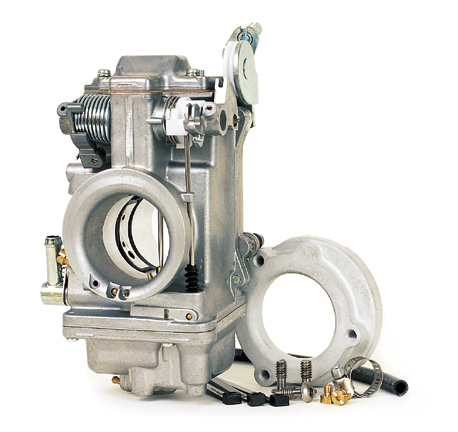
This was no ordinary installation. First,time was a factor, second it’s no normal, stock carburetor swap. The 98-inchS&S motor offered taller cylinders and improper intake manifold fitment.The stock Super E S&S manifold was too big for the 42 mm polished MikuniCarburetor. Stock manifolds shove the carb out too far and aren’t wideenough for the tall S&S cylinders so a quick call was made to JamesSimonelli of S&S who rushed the correct manifold to Mikuni. Lee alsowanted to explore an American Iron Horse manifold available for their customswhich pull the carb in closer to the engine and “L.T.” or James Littleof American Iron Horse moved equally fast and the parts were in hand inone day. The next hurtle: The cables. A call went out to Xavier at BarnettCables who turned about a set of Mikuni compatible cables which are setup the same as stock H-D cables, but cut to Bryan’s specifications forthe job. They also arrived in time.
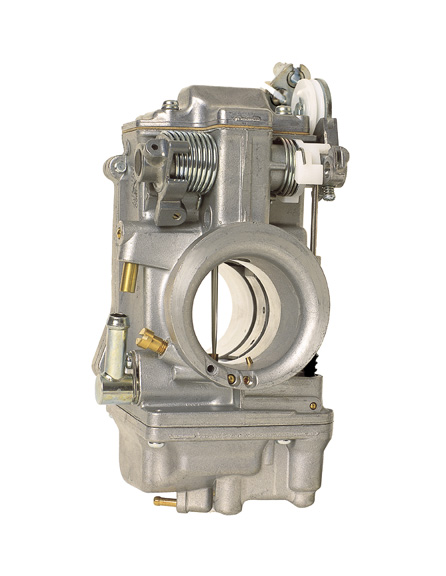

Bryan pointed out an adjustment on theleft side of the carb as you face it, a main jet air adjustment. He toldme to inform Bandit to turn it out a half turn in Denver for more compatiblerunning in altitudes. The bike immediately fired to life for the firsttime. Two weeks to go.
Bikernet West – The Chop Lives
By Robin Technologies |
|

The speedometer arrived from the Dallas Easyriders with a little over 24 hours to kick-off. The cable was coiled in a cardboard box waiting and the drive unit was already bolted to the front wheel. Unfortunately, the cable was the wrong unit and a hunt began for the proper cap. A call from Phil, the Hamster painter, encouraged Bandit to send a young lady to see Jim at Drag Bike Engineering. He had the cable and, at three in the morning, Bandit was installing it. We will also follow this series with an article on the Weerd Bros. front ends. This is a ball-milled wide glide that, depending on what ruler you use, is approximately 14-over. According to Bandit, who is in the garage packing as I hit the keys, the front end is light handling with narrowed flat track bars due to the six degrees of additional rake. Even with an overall 44 degrees of rake, the front sliders are smooth and work effortlessly. Although this is a European-built front end with metric Allen head fasteners, it’s highly adjustable with removable fender mounts and brake caliper mounts that can be installed on both lowers or either one or none for the hardcore muthas.
 Bandit’s about to take his Blue Flame for a final test ride with his bed roll centered over the Weerd Bros. front end. Yesterday, during the heat of the harbor day, a small Fed Ex package arrived. It was from C.J., the old biker engraver. Inside was a Bikernet engraved point cover, a “Bandit” money clip, and a flamed mag light. When more photography is revealed of the Blue Flame, the Bikernet logo with our babe mascot will be revealed in all her nearly nude glory. Damn, when she walks into the sagging headquarters, everything stops, as if a contact high permeated the garage. In a daze we watch her every fluid move. By reader demand we will post a photograph of the lavish facility in the next couple of weeks.
 The bastard is rolling out in the wee hours of the morning and the race will be on for the Badlands. Agent Zebra will be heading out of Miami at noon on Saturday heading north and into Tennessee, as Bandit heads east across the border into Arizona where he will relieve his helmet of duty and ride on in freedom toward Phoenix.
 More reports are forthcoming. Live from the Bikernet World Headquarters in San Pedro, California. This is Renegade. Over and out.
|
Sturgis 2000 Project Bike – Bandit II Lives
By Robin Technologies |
 |
| Each custom motorcycle has a story. That’s one aspect of this treacherous world that sets it apart from stock bikes. Stop any rider of a chop and ask him about his bike and he’ll either punch you in the face or tell you how he started to build his bike, lost his wife and family in the process, and had to sell his home and move into a rented garage in order to complete the project. There’s a story of romance, heartbreak, hard work, and struggle behind any bike. This one is no different.
Now comes another saga, equally terrifying, equally fraught with intrigue and heart. This tale of woe begins five years ago with a project conceived with Ron Simms of Bay Area Custom Choppers. The plan was to build a bike as a tribute to the ’30s. But times changed and attitudes became harsh as the unit came together. The more we worked, the farther the project ventured from the reality of the hard-riding world. |
|
| Ultimately, the bike was finished and featured in the February issue of VQ magazine. As a tribute to all who worked on it, we will feature the entire list of talents that it took to complete (…see the partial list of the crew). The sad part of the story is that the bike was ultimately unrideable. Hell, we couldn’t even trailer it to shows without damaging the chassis, and the bike was put up for sale with less than a couple of miles on it.
But we don’t like the idea of selling something that our brothers helped us build and a suggestion was made to turn it into the ultimate ground-pounding, coastal-bar-hopping bastard. We pondered the thought. We kicked around the years it took to build it in its current form, the times we went through, the love that was lost and gained, the adventures, the rides, and the wild times to come. We thought about Sturgis 2000 and what to ride. I spoke to my brothers. We had considered riding old bikes. So the gauntlet was tossed into the ring. Build a rigid flyer from the pieces of the Bandit II and keep it alive, or put dual carbs on a ’48 Panhead and take our time? Ah, but the Bikernet staff can’t proceed with anything that’s status quo, we’ve got to tear the whole enchilida to the ground and start over, and do it with a vengence. At another meeting at Harold’s dive bar in San Pedro while tossing back stout glasses of Jack, a contest was conjured up. Bikernet East (the chicken-shit Agent Zebra who couldn’t hold a job in Los Angeles and escaped to Miami with his European nymphet) against Bikernet West (Bandit himself, riding a Daytec Rigid). Since the homeless, jobless bastard of Barstow doesn’t have a dime to his name, but still writes vile stories about the upstanding members of Bikernet, we voted to build him a bike to ride to Sturgis. Bandit was already tweeking the drawing board with parts from the Bandit II, hence a contest. Bikernet East rides against Bikernet West to the Badlands and we’ll take a vote as to who has the coolest bike that makes it. Yeah that’s right – gotta make it there to be voted on. |
|
 Photo One |
As it turns out, we will be able to use the entire driveline from the Bandit II for the Bikernet West rigid chop, including the 98-inch S&S, Simms-built motor (photo 1) and Custom Chrome transmission. It will be placed into one of Daytec’s 4-inch stretched, wide-tire rigid. |
| The Harley-Davidson narrow glide (photo 2) will stay with the original Paughco frame for the Bikernet East project and a new long front end will grace, perhaps a Weerd Brother glide, the Daytec chassis. |  Photo Two |
 Photo Three |
Two Road Wings 60-spoke wheels have been laced and mounted to Avon tires. The front will be a 21 with a 5-inch wide 18 on the rear. And Bandit picked up a Yaffee sidemount license plate/taillight. All the brakes and controls will remain Performance Machine (photo 3). |
| Harold Ponterilli will paint the reincarnated Bandit II cobalt blue with ’60s metal flake silver flames touched off with white pinstriping. The Bandit II will live to fly through the streets of Long Beach, Pedro, and L.A. And perhaps, if all goes as the Lord of Choppers dictates, across the desert into the Badlands this year.
You’ll see the entire saga unfold on bikernet, good, bad or ugly. |
|
| Ride Forever, –Bandit |
|
Bikernet East – Zebra’s Chop Unveiled
By Robin Technologies |
| When the dust and metal filings settled, the smoke cleared, and the greasy gang of wrenches at the famous Bikernet Garage sobered up, before us stood a gleaming new chopper, complete and ready to break in, save for a few minor tweaks and a seat.
 The Zebra entry for the Bikernet ChopOff 2000 was complete. The Great Northern Steamer, scheduled to blast from the Caribbean shores of South Beach, Miami, all the way to the western Badlands of Sturgis, South Dakota, stood shimmering in the Southern California sunshine. A moment of silence occurred naturally. Then Bandit farted. The Great Northern Steamer is the first complete entry (or virtually so, save for custom seat, a bit more paint, and a few tweaks and adjustments) to come off the steaming chopper assembly line at the Bikernet West garage in San Pedro.
 She’s a fast horse, with no bells, no whistles and a low, clean look. This is a true garage chop. Comprised of our favorite parts from our bad-assed vendors who work with us at Bikernet, the Zebra chop should be a joy to ride and not bad on the eyes either. She’ll roll on new Avon rubber, a 21 up front and a 150/16 in the rear, which is as wide as you can go on a stock softy frame without moving swingarms and trannys. We kept her this way because we know a lot of bros don’t have access to zillion-dollar bank accounts and nine-month time periods to re-engineer entire frames. The Zebra chop was purposely built to be an every-man’s chopper—something any of us could build right in our own garage with a bit of determination and hard work. The Avon rubber will be wrapped around newly released Harley-Davidson Thunderstar rims. The engine is a salty RevTech 88 from Custom Chrome and came out of the box humming like a dragon sitting on a cattle prod. I can’t wait to get past the break-in and give that big horse some oats and see what she’ll do.
 Expect me and whatever lucky lass I decide to strap on the back to arrive early in Sturgis this year. The tranny is a pussy-smooth Baker 6-speed, known for strength (I’m a bit heavy handed on clutches as Bandit is always pointing out) and high-end gearing. I prefer the left lane. We took the narrow-glide front end off the Bandit II along with the lighthouse-bright Headwinds headlight and slipped it on. I might have Eddie Trotta at Thunder Designs in Ft. Lauderdale, Florida, (where the bike will be received after being shipped from our garage in San Pedro by Ken Gold) throw on a set of wide-glide triple trees. The jury is still out on that one. Eddie and his men will also be in charge of sharp shooting our work, checking for any errors, and handling break-in oversight. All the wiring was done by our resident electrical genius, Bandit, who spent the better part of his three tours in Vietnam keeping the big guns of his heavy cruiser wired tight and barking day and night. The handlebars are Cyclesmith and set flat and low, like the horns on the big bulls that periodically tried to hook my guts out when I rodeoed. Everything hangs off a Ron Paugh special, a Paughco frame, stretched five inches and raked. She’s got a Harley-Davidson battery. The pipes are also from the Bandit II and were initially a ThunderHeader system, the header part, which we sliced off. Now it’s a pair of flashing noise downspouts that make the big RevTech 88 sound like God falling down the stairs when you roll it on. Talk about a sound boner. The call of this big bull will swoon any lass who’s not deaf. The Ride Lo lowering kit actually took the chop a bit too low and we’re planning on having Eddie Trotta’s boys crank it up a few inches so when I load my 220-pound ass on along with a couple hot rod blondes I scoop up from the topless beach in Miami (I’m not kidding, bros, it’s topless, you should visit), the sucker won’t spark all the way to SD. It’s a chain drive up front, rubber in back. I know everyone says the chains look good in the rear, but they buzz the guts out of my ladies and I’d rather have a 20-year-old, six-foot goddess from Spain on back than a sparkly chain any day. I can do more with the Spaniard when I get to where I’m going, if you get my drift. The oil bag was a complete motherfucker and we re-hung it about as many times as a cattle rustler in Kansas who gets caught on your favorite horse with your old lady thrown over the saddle horn and your best rifle in the scabbard. Phil Stadden painted the custom front fender and stock Fat Boy rear fender, which we bobbed considerably. The paint job matches the existing burgundy paint on the Paughco frame, which was one of the parts we got back from West Coast Choppers. Still waiting on the others. I’ll store my gas in a stretched FXR tank that was jerked long by Russ Tom in Seattle.
 We have a left mirror, the right seems to be lost in the West Coast Choppers abyss of “missing” parts, so I may have to buy two new mirrors or just run the right side glass. I will take the German Feminine (we’re a bit on the outs at the moment, so we’ll see how this part goes) up to Eddie Trotta’s Thunder Design in Ft. Lauderdale when the Great Northern Steamer gets in and measure for a seat and passenger footpegs. I’m going to try to construct a good-looking seat that seats two comfortably, but retains the very low-profile look of the bike we’ve created. The footpegs will probably sit about an inch behind mine, since the German Feminine was born with enough leg to wade in the deep end of the pool. We may also add a very striking and radical sissybar to keep all of my lovely European sweethearts on the scoot as I cavort about the balmy regions of Miami. At the moment, the highest point on the entire bike sits at about belt loop height and I’d like to keep it that way. But if I have to add a sissybar to keep my ladies from burning their breeches on the twirling rear Avon, then I’ll construct something radical and good looking to throw behind them. If I can get Bandit away from the Jack and women to actually send one out, I’ll probably also throw one of the very handy and well-designed Bandit Dayrolls up front to hump gear and any small tools. Thanks to all the bros at Bikernet West who helped wrench together my entry for the Bikernet Chop-Off 2000. Bandit was the master wrench in charge and spent many a thankless hour, welding naked and screaming in the spooky recesses of the Bikernet garage in San Pedro and deserves a clean clap on the back for a job well done. I’ll keep you posted as I run the new horse through her break-ins down in the 100-degree heat of Little Havana and blow off that new chop smell. Hope all you bros out there are getting your scoots ready for the big run and we look forward to blasting north into the Badlands for some serious partying, eating, drinking, and of course loving the ladies in Sturgis. Now the focus shifts to getting Bandit’s entry completed. His scoot is looking damned good so far and the air wrenches are singing the Bikernet national anthem day and night. Bandit and I will be arriving on (we hope) the 5th, covered in bug guts and bragging rights to start campaigning for the big vote to see which chop the bros chose as the Bikernet Chop of the Year.
 Grease up and get your gear, bros, it’s almost time for the big run... May the best badass win. See you in Sturgis. Ride hard, Bikernet East |
Bikernet West – Electronics in a Weekend
By Robin Technologies |
|

Wiring is the nemesis of man, the puzzle of the best builders, the hornet’s nest of breakdown treachery. Bandit sat for hours drawing a wiring schematic for Agent Zebra’s Softail, only to rip it to shreds and toss it in the trash. He made lists while Sin Wu brewed strong coffee and baked peanut butter cookies. Bandit barked and growled for a couple of days with each run to the marine store for connectors, to the electronics store for switches, to the Custom Chrome catalog for components. The same formula fit his own West Coast entry in the Sturgis Bikernet Chop-Off. We knew as soon as he mentioned that the bike was ready to wire, that we should pack our shit and leave. We took the case of Jack fifths, the girls, and checked into the nearest fleabag motel. While we sat around the stanky pool and partied, Bandit thought about each wire, each connection, and each component. His mentor, Giggie from Compu-Fire, was his only sounding board and the only sonuvabitch big enough to snap back when Bandit growled about wire gauge or lost connectors. He wired the bike entirely with 14-guage wires. The only other sizes used were for the battery cables (stock units) and the wire that ran from the battery to the ignition switch (12-guage). Even when the sexually starved statuesque Asian roamed into the garage with cocktails, adorned in a sheer negligee, she was ordered back to the headquarters. Soon she found another plaything to keep her occupied, but that’s another story. Wiring, in the big guy’s mind, is a process of understanding what is happening with each component, where each component is located, watching for the safety of each wire, keeping the bike sanitary, and organizing each group of wires. Each wire is covered with shrink tubing, each connector supported with additional shrink tubing. Each bike had a minimum of wires carefully placed. Each bike had a minimum of components to keep the wiring process uncomplicated or enhance the reliability of the machine. No turn signals, no handlebar controls, and no micro switches. He used only millspec (military specifications) or marine quality switches. Vibration is a killer on motorcycles and much the same on boats, in addition to the moisture considerations. One additional component made wiring simple and risk free, the Custom Cycle Engineering starter mounted mechanical switch. (Check the article here in the Garage.) This unit eliminated the starter button, the starter relay, and all the associated wires. You must make sure you will have access to the switch, which is mounted directly on the starter, under the oil bag, (Photo 2) which can easily be interfered with by the position of the exhaust pipes.
 Photo 2
The concept is that you physically push the solenoid into contact with the starter gears and electrically engage the starter. We chose a Compu-Fire starter from Custom Chrome to kick this 98-inch monster to life. The key thing on fucking up starter motor installation is over tightening the brass lug wire fitting. It may turn the connection on the inside of the starter and ruin the contacts. Compu-Fire has designed a new line of starters which feature 6:1 gear reduction (Photo 3) and a 6-pole permanent magnet field to eliminate starter stall-out.
 Photo 3
These units deliver maximum cranking torque without overloading the battery. They also eliminate starting problems on fuel injected bikes. Only two switches were used and one 30-amp H-D (common at any electronic or auto parts store) circuit breaker. One on-off marine toggle for the ignition, which energized the Compu-Fire single-fire ignition system, the hydraulic brake switch, and the taillight. Since all the sweet parts like handlebar controls, foot controls, mirror, and taillight were Joker Machine components, he was in luck. Joker works the brake light switch into the body of forward controls, which eliminated the bulky hydraulic switch, the junction, and a two-piece rear brake line. Another wire went to the other switch, an on-off-on switch for the headlight (high/low beam). Two wires were run from it to the headlight. Daytec does a beautiful job of running guide tubes in the frame to hide the wires. Initially, if you chose to do so when ordering a Daytec frame, you can have two inserts welded to the frame seat post rail for electric box mounting. We ordered the certs for this frame but decided that with the simplified wiring program we could stuff switches and all the wires into the structure of the top motor mount. This was Giggie’s suggestion and Bandit readily agreed (a miracle). With careful measurements the switch holes were drilled with several bits until a 1/2-inch hole for each switch was attained. The only guide hole that the frame was missing was one for the headlight wires, but two wires were run through shrink tubing to the headlight and through a 5/16 hole in the motor mount. One wire was run from one side of the ignition switch to the circuit breaker, another, the 12-guage wire ran to the battery. From the circuit breaker a wire ran to the taillight down another guide hole along with the brake switch wire. From the brake switch another wire ran to the taillight, brake element. We also used a Compu-Fire regulator, which mounted to the front of the motor. One wire ran from the regulator back to the hot lead on the Compu-Fire starter motor. Bandit used the excess 12-guage wire to run from the battery to the hot side of the ignition switch. Giggie recommends that you use crimpers designed for Duetch connectors for a solid, vibration-handling connection. Bandit used water resistant connectors from a West Marine store. After some 20 hours in the garage, Bandit was finally lured into a well warmed King size bed by Sin Wu and her girlfriend Coral as the sun came up, but at that point the bike was ready to be fired to life. The question was, could Bandit be fired to life? –Wrench
|















